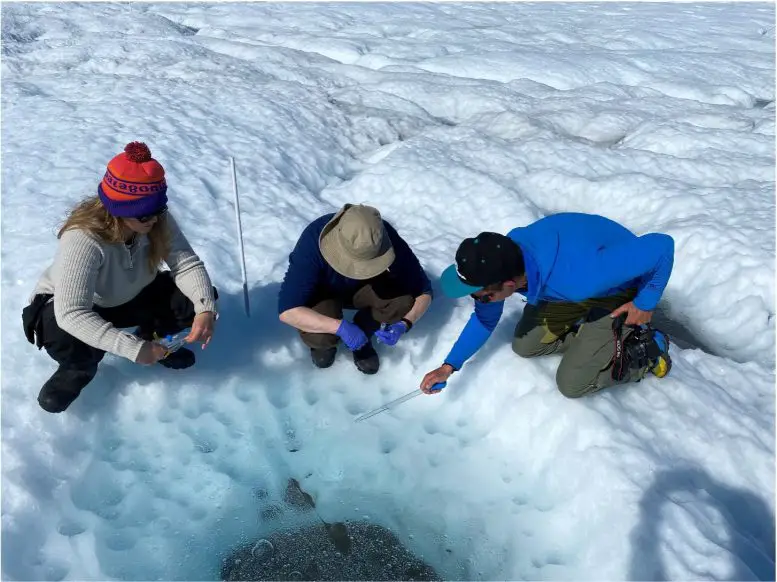Greenland ice is teeming with life both above and below its surface. Until recently, science was unaware of the existence of some microscopic organisms living there. Recent discoveries even suggest that these tiny creatures are responsible for adding color to the ice and speeding up the melting process.
Greenland’s glaciers are considered icy deserts where life is lacking due to extreme conditions. Due to the lack of vegetation and the limited number of animals, this area receives very few visitors. Massive ice sheets make survival difficult and uninhabitable. However, recent discoveries have cast doubt on this idea. There is much more life in glaciers than we think.
A group of researchers from the Faculty of Environmental Sciences at Aarhus University, led by Professor Alexander Anesio, discovered that the glaciers are teeming with life. Microbes adapted to life on ice. And not one or two types. Several thousand different species.
“A small pool of meltwater on a glacier can easily host 4,000 different species. They live on bacteria, algae, viruses, and microscopic fungi. It’s a complete ecosystem that we didn’t even suspect existed until recently,” says Alexandre Anesio.
What do microbes live with?
Over the past 50 years, researchers have repeatedly admired the durability of life. Life is found several kilometers underground – where there is neither sun nor oxygen. Billions of microorganisms “eat” minerals in the rock so they can survive.
Researchers have shown that life can even exist in space. In 2007, European researchers placed more than 3,000 colonies of microscopic tardigrades on the outside of a satellite and sent them into Earth orbit. The flight lasted 10 days, after which the satellite returned to Earth. At least 68 percent of microbes have survived the vacuum of space and deadly radiation.
Therefore, it may not be surprising that life also flourished on glaciers. After all, there is sun, oxygen and water. However, until recently, researchers believed that ice had too few nutrients to support life. But they were wrong. There is nutrition. Incredibly small amounts, explains Alexander Anesio.
black algae
One of the microorganisms on the ice that researchers spend the most time studying is tiny black algae. Algae grows on the surface of the ice and darkens it. There’s a reason black algae are so interesting to researchers.
“When ice gets dark, it becomes harder to reflect sunlight. Instead, the heat of the sun’s rays is absorbed by the ice that is starting to melt. The more the ice melts, the higher the temperature on Earth. Therefore, algae play an important role in global warming,” says Alexander Anesio.
In recent years, increasingly large areas of ice have been tainted with algae, causing the ice to melt even faster. Alexander Anesio estimates that algae accelerates the melting of ice by about 20 percent.
Ice algae existed before humans began to industrialize global warming. However, climate change means spring in the Arctic comes earlier and earlier, and as a result, algae will have a longer time to grow and spread.
“Every year the algae spread a little more. When I go to Greenland, I see huge areas where the ice is completely dark because of the algae,” he says.
NASA is watching its research too
Alexander Anesio’s research on life on ice is important for better understanding climate change. However, NASA is also closely following the results of its research. The results could be crucial in the search for life in space.
“NASA has approached us a few times because we’re working with life in one of the most inhospitable places on Earth. If life thrives on and under ice, it’s likely that we’ll also find life in the ice on Mars or, for example, on the icy moons of Jupiter and Saturn,” he says.
Before NASA sent the Perseverance rover to Mars, they even invited Alexander Anesio to a meeting.
“They were afraid the rover would take microbes from Earth with it. Microbes that could live on Mars and contaminate samples from Mars. So they wanted to know under what conditions life could survive. What are the limits of life?”
It can give an indication of what they should look for
NASA is very interested in discovering life in ice because we haven’t found liquid water on other planets in the solar system. Not yet. But we found a lot of ice.
However, there is evidence that Saturn’s moon Enceladus and Jupiter’s moon Europa have liquid oceans beneath the frozen surface, and that liquid water is one of the vital conditions for life as we know it.
That’s why NASA and other space agencies are very interested in learning more about the types of life that can live on and under the ice. That’s because organisms similar to those in Greenland are likely to search during the icy moons.
Source: Port Altele
